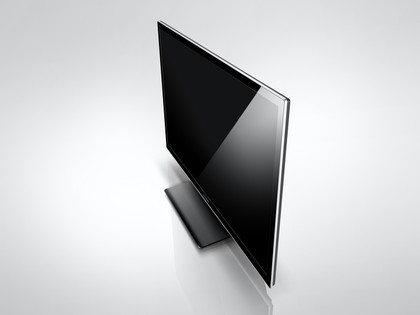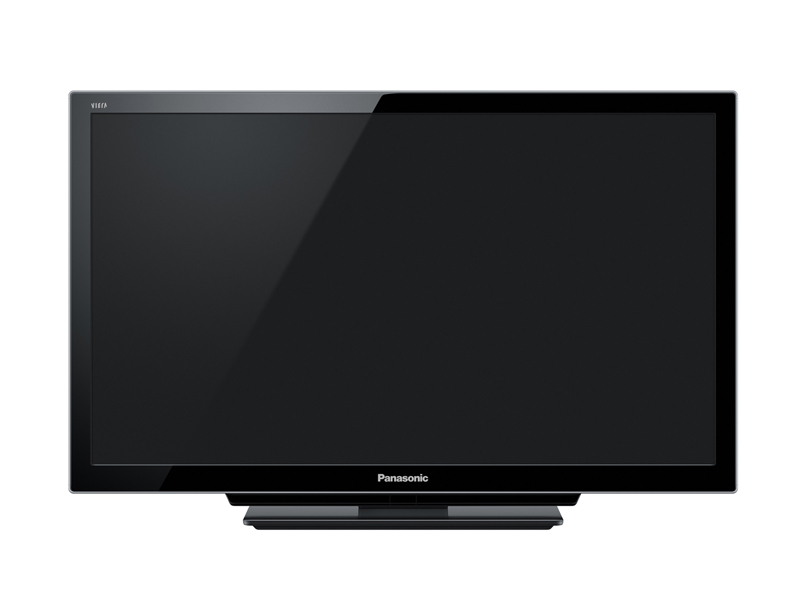Why you can trust TechRadar

While the TX-L32DT30's design isn't going to win any awards, it joins Panasonic's E30 models in being a big step forward from the brand's previously rather dour approach. It's impressively slim over most of its rear, and feels extremely well built and metallic to the touch.
Its bezel is strikingly narrow – noticeably more slender than those of the E30 models – and there's a tasteful silver trim around the set's extremities.
The only discordant note in the TV's design, perhaps, is the rather hefty bulge that runs along the back of its lower edge that contains some proper speakers in place of the impossibly thin, almost invariably rubbish drivers you tend to get with most skinny TVs.
The TX-L32DT30B continues to look every inch the 2011 trendsetter by carrying a prodigious set of connections. Four HDMIs get the ball rolling, but more exciting is the amount of multimedia stuff at your disposal.
For instance, there are no fewer than three USB ports, which looks like no more than is necessary when you consider that as well as playing video, music and photo files from USB storage drives, you can make the TV Wi-Fi capable via an optional USB dongle, and record from the TV's digital tuners to compatible and formatted USB hard-disk drives. Panasonic assures us, moreover, that recordings are now possible on a much wider range of powered USB hard-disk drives than was previously the case.
Also massively important to the TX-L32DT30B's 2011 credentials is its LAN port. Unless you go the optional Wi-Fi route, this is your portal to not only content stored on your DLNA PC but also the Viera Connect online platform.
What makes Viera Connect different to its Viera Cast predecessor? For one thing, its cloud-based system is shifting much more overtly towards the apps content model now familiar to so many people thanks to smartphones. The home page of the Viera Connect area now includes a box that takes you straight to a new 'marketplace', where you can choose which apps you want to install on your TV.
At the time of writing there were around 40 apps available from the market, all of them free. But you can bet your bottom dollar that the number will grow substantially over time and that a number will only be available if you pay for or subscribe to them.
Rather a lot of the 40 apps were for foreign language services, but the genuinely useful ones include YouTube, AceTrax (the film purchase/rental site), Skype, Eurosport, and those seemingly indispensable bastions of the modern world, Facebook and Twitter. Plus, thankfully, Panasonic has finally realised that it really needs the BBC iPlayer onboard.
Viera Connect is also much more interactive than Viera Cast. For within the marketplace you will ultimately be able to order hardware accessories to support upcoming gaming and health/fitness services. Among the accessories announced so far are a joystick, a set of scales, a pulse-monitoring armband and even a treadmill, so you can recreate the gym experience of jogging while watching something encouraging on a TV.
Although not available to test at the time of writing, these accessories have already been shown working, with the joystick even being seen to control a surprisingly decent looking racing game at some demos.
Viera Connect's cloud-based approach means it can be upgraded easily with new features and services. It's an open-platform system, too, so you can expect plenty of third party apps to appear as time goes by.
Heading into the TX-L32DT30B's onscreen menus uncovers plenty more features to get your teeth into. Particularly welcome, considering that the TX-L32DT30B is far from cheap by 32-inch TV standards, are the set's ISFcc presets, indicating that the TV has been endorsed by independent specialist the Imaging Science Foundation and that is better equipped with picture adjustments than Panasonic's non-ISF TX-L37E30B model.
Select the Advanced ISFcc setting in the setup menu, and you can adjust the gain and cut-off levels for the red, green and blue colour elements, as well as their hue, saturation and luminance levels. Plus you can choose from a series of gamma presets.
Also additional to the features found on the L37E30 is a Clear Cinema Mode, which interestingly improves vertical resolution for movie images, so long as they're interlaced.
Otherwise, aside from some 3D options we'll get to in a minute, the picture adjustment options available are broadly the same as those found on the L37E30. So they include a resolution enhancer for improving the sharpness of, especially, standard-definition sources, and the option to adjust the strength of Panasonic's Intelligent Frame Creation processing for reducing judder and motion blur. It's a shame, though, that the level of IFC control is limited to simple off, Mid and Max settings. More on this later.
The 3D options include a 2D-3D converter with the adjustment to shift the 3D effect between low, mid and high levels, plus the option to turn on or off auto 3D detection so that the TV can spot a side by side 3D source such as Sky's 3D channel. There's also an interesting option for activating a 100Hz 3D refresh rate (though you're probably as well sticking with the default Auto setting, to be honest), and the ability to adjust the extent of the 3D effect with 3D Blu-ray source content.
The latter tool is perhaps a little controversial, as it means people can mess with the depth settings decided on by a film's 3D mastering people, but then Panasonic might reasonably argue that 3D is all about personal preferences/tolerances.
Wrapping the TX-L32DT30B's key features up are the new developments Panasonic has introduced to make its edge-lit LED TV better able to handle 3D inputs. Arguably the most significant of these concerns the panel itself. For Panasonic has narrowed the gap between the backlight and screen, and introduced a liquid crystal material with a higher level of fluidity - features which both help to speed up the new LED TVs' response time by as much as 50 per cent.
Reducing LCD response times is essential if you want to fight the crosstalk ghosting issue so common with last year's LCD 3D TVs, so it's not entirely surprising that Panasonic hasn't left its speed-boosting innovations merely to the panel improvements. The TX-L32DT30B also uses high speed 'advanced pre-charge driving' technology – essentially 200Hz scanning plus a blinking backlight – to boost the screen's scanning time and thus leave the screen with almost twice as long to react to the change from left eye image to right eye image.
Panasonic claims that the reason it didn't introduce any 3D LCD TVs last year was because it didn't believe that it had solved the response time issues sufficiently well to make a 3D product good enough to meet its own performance targets. It's worth adding, too, that the improvements introduced for 3D should also help 2D.
Current page: Panasonic TX-L32DT30B: Features
Prev Page Panasonic TX-L32DT30B: Overview Next Page Panasonic TX-L32DT30B: Picture qualityJohn has been writing about home entertainment technology for more than two decades - an especially impressive feat considering he still claims to only be 35 years old (yeah, right). In that time he’s reviewed hundreds if not thousands of TVs, projectors and speakers, and spent frankly far too long sitting by himself in a dark room.

